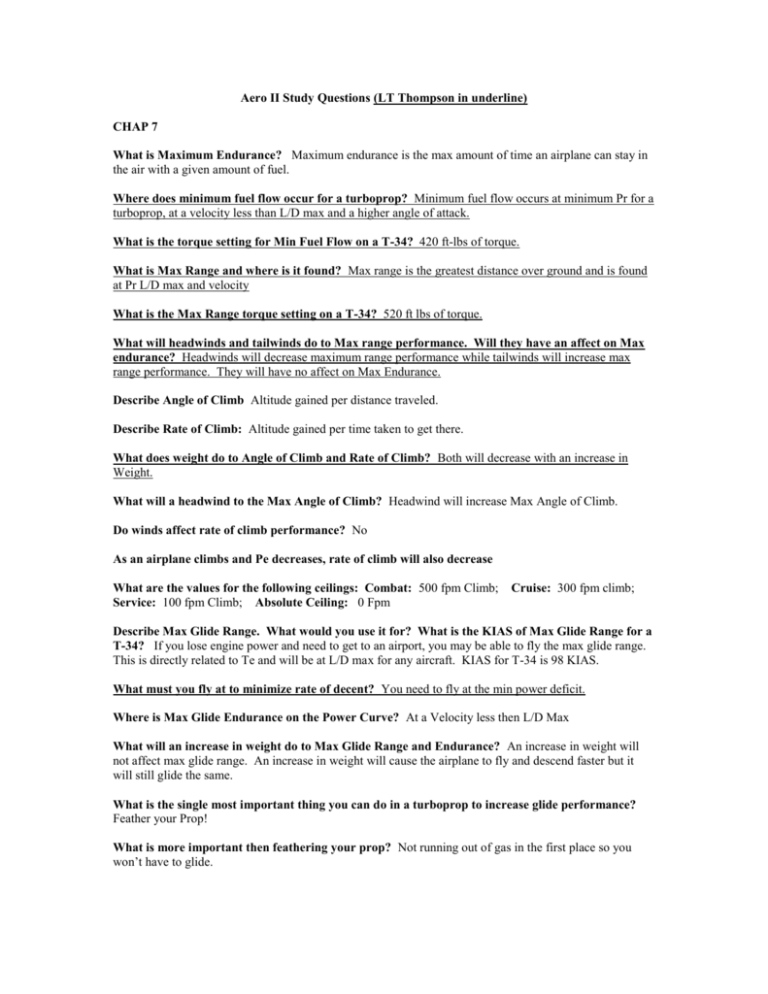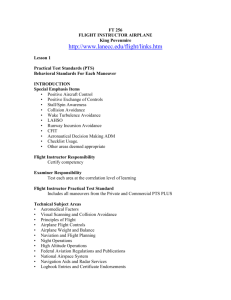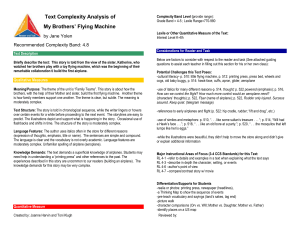Aero II Study Questions
advertisement

Aero II Study Questions (LT Thompson in underline) CHAP 7 What is Maximum Endurance? Maximum endurance is the max amount of time an airplane can stay in the air with a given amount of fuel. Where does minimum fuel flow occur for a turboprop? Minimum fuel flow occurs at minimum Pr for a turboprop, at a velocity less than L/D max and a higher angle of attack. What is the torque setting for Min Fuel Flow on a T-34? 420 ft-lbs of torque. What is Max Range and where is it found? Max range is the greatest distance over ground and is found at Pr L/D max and velocity What is the Max Range torque setting on a T-34? 520 ft lbs of torque. What will headwinds and tailwinds do to Max range performance. Will they have an affect on Max endurance? Headwinds will decrease maximum range performance while tailwinds will increase max range performance. They will have no affect on Max Endurance. Describe Angle of Climb Altitude gained per distance traveled. Describe Rate of Climb: Altitude gained per time taken to get there. What does weight do to Angle of Climb and Rate of Climb? Both will decrease with an increase in Weight. What will a headwind to the Max Angle of Climb? Headwind will increase Max Angle of Climb. Do winds affect rate of climb performance? No As an airplane climbs and Pe decreases, rate of climb will also decrease What are the values for the following ceilings: Combat: 500 fpm Climb; Service: 100 fpm Climb; Absolute Ceiling: 0 Fpm Cruise: 300 fpm climb; Describe Max Glide Range. What would you use it for? What is the KIAS of Max Glide Range for a T-34? If you lose engine power and need to get to an airport, you may be able to fly the max glide range. This is directly related to Te and will be at L/D max for any aircraft. KIAS for T-34 is 98 KIAS. What must you fly at to minimize rate of decent? You need to fly at the min power deficit. Where is Max Glide Endurance on the Power Curve? At a Velocity less then L/D Max What will an increase in weight do to Max Glide Range and Endurance? An increase in weight will not affect max glide range. An increase in weight will cause the airplane to fly and descend faster but it will still glide the same. What is the single most important thing you can do in a turboprop to increase glide performance? Feather your Prop! What is more important then feathering your prop? Not running out of gas in the first place so you won’t have to glide. Describe Reverse Command: Reverse Command is when you are on the left of the thrust and power required curves. To slow down, you must increase power and increase AOA and to speed up you must decrease power and decrease AOA. Keep in mind that Altitude remains constant. CHAPTER 8 What do Trim Tabs do? They reduce the force required to hold control surfaces in place to maintain desired flight attitude. What direction do they move relative to control surfaces? Trim Tabs must always be moved in the opposite direction as the control surfaces to reduce pressure. Describe Aileron Trim: Aileron trim is adjusted just after takeoff and is then rarely adjusted, In the T-34 only the left trim tab is moved, right one is set by maintenance. What is control balancing? Control Balancing: Aerodynamic center must be balanced around the hinge line in order to regulate control pressure, prevent control flutter and provide control free stability. What does the T-34 use for Aerodynamic Balancing? T-34 uses shielded horns on the elevator and rudder and an overhang on the ailerons. What/how is mass balancing used on the T-34: For the T-34 to locate Center of Gravities on the hinge line, weights are placed inside the control surfaces in the area forward of the hinge line. This is called mass balancing. T-34 uses conventional controls, a servo trim tab on the aileron, anti servo control on the rudder, and Neutral Trim Tabs on the elevator. What are Downsprings and Bob Weights and where are they used on the T-34? Elevator uses bob weights and downsprings to provide pilot with artificial feel for elevator. Downspring increases the force to pull back on the stick at low airspeeds. The bobweight increases the force required to pull back during maneuvering flight. In the movie Top Gun, what is Iceman’s real name? Tom Kazansky, played by Val Kilmer Describe all control movements (Elevator, Aileron, Rudder) Elevator controls pitch, Aileron controls Roll, Rudder controls Yaw. CHAPTER 9 The Chart on C-7 is important to know for this chapter. Define Stability: Stability is the tendency of an object to return to a state of equilibrium after it has been disturbed. What is Static Stability? Static Stability is the initial tendency of an object to move toward or away from its original equilibrium position. What is Dynamic Stability? Dynamic stability is the position with respect to time, or motion of an object after a disturbance. What is Positive Static Stability? Positive Static Stability is an initial tendency toward its original equilibrium position after a disturbance? What is Negative Static Stability? The tendency to continue moving away from the equilibrium following a disturbance. What Neutral Static Stability? The initial tendency to accept a new displacement position. Undamped Oscillation is constant oscillation about a point, usually found with Positive Static and Neutral Dynamic Stability. What is Directional Divergence? How is it caused? Directional Divergence is a condition of flight in which the reaction to a small initial sideslip results in an increase in sideslip angle. It is caused by negative directional static stability. How Does Spiral Divergence Occur? Spiral Divergence occurs when an airplane has strong directional stability and weak lateral stability. Which weights more, a pound of feathers or a pound of steel? Neither, they weigh the same. What causes Dutch Roll: It is the result of strong lateral stability and weak directional stability. What is proverse roll and adverse yaw. Proverse is the tendency of an airplane to roll in the same direction as its yawing. Adverse yaw is the tendency of an airplane to yaw away from the direction of aileron roll input. What is Slipstream Swirl? Slipstream Swirl is the propeller swirling air around the fuselage hitting the left side of the vertical stabilizer causing a tendency to yaw left at height power setting and low velocity. What is P Factor? P factor is the yawing movement caused by one side of the prop creating more lift than the other. Describe what happens with thrust line as it relates to relative wind. If the relative wind is above the thrust line (at height velocities and low AOA), the upgoing blade on the left side creates more thrust and this will cause the plane and yaw to the right. If the relative wind is below the thrust line (height AOA and low airspeeds, near stall) the down going blade on the right side will produce more thrust and the plane will yaw to the left. Happens during takeoff and landing. CHAPTER 10 What is a spin? A spin is an aggravated stall that results in auto rotation. What is Auto Rotation? Autorotation is a combination of roll and yaw that propagates itself and progressively gets worse due to asymmetrically stable winds. Which has the higher AOA on the wing during a spin? The down going wing has a Higher AOA than the upgoing wing. Which part of the wing has a greater Cl? The upgoing wing has a greater CI due to its smaller AOA. Which part of the wing has the greater Cd? The down going wing has a higher Cd due it’s increased AOA. What one of your most reliable instruments during a spin? In a spin, the turn needle is the only reliable instrument, however, disregard the ball. Altimeter Airspeed AOA Turn Needle Erect Spin Flat Spin Inverted Spin Decreasing Decreasing Decreasing 80-100 KIAS 0 KIAS 0 KIAS 30 Units (Pgd) 30 Units 2-3 Units Pgd in direction of spin Pgd in direction of spin Pgd in direction of spin Describe a Progressive Spin: A progressive spin occurs when full opposite rudder is applied but you hold full back stick pressure. How do you recover from a spin? To recover from a spin, input full opposite rudder and push the stick forward of neutral. What happens if you don’t recover from a spin? You die What is an aggravated spin? How do you recover? An aggravated spin comes from pushing the stick forward while maintaing rudder in the direction of the spin. Recovery is to input full opposite rudder and stick slightly forward of neutral. CHAPTER 11 In a turn, only the vertical component of lift opposes weight. What is Load Factor? Load factor is the ratio of total lift to airplane weight, sometimes known as G. N=L/W Why are Vs and IASs called accelerated stall speeds? Vs and IASs are called accelerated stall speeds because they represent stall speeds at velocities greater than minimum straight and level stall speed, and load factors greater then 1. What happens to Stall speed as load factor increases? Stall speed increases when airplane load factor increases past 1. What is Static Strength? Static Strength is a measure of a materials resistance to a single application of a steadily increasing load or force. What is Static Failure? Static Failure is the breaking of an object due to cyclic application of load or force. What is Service Life? Service life is the number of applications of load or force that a component can withstand before it fails. What is limit Load Factor? Limit Load factor is the greatest load factor an airplane can sustain without the risk of any permanent deformation. What is the Load Factor Limit for the T-34? For the T-34 the limit is +4.5g and –2.3g. What is the elastic limit? The elastic limit is the maximum load that may be applied to a component without permanent deformation. What is the ultimate load factor? What is the usual Ultimate Load Limit? The Ultimate Load factor is the maximum lad that the airplane can withstand without structural damage. There will be some deformation at this point; however, if it is past then structural failure is imminent. The Ultimate load limit is 150% of limit load factor. What is the maneuvering point? The point where the accelerated stall lines meet the limit load factor line is called the maneuvering point. It is the point that if you are to the left, no damage will occur. What is the maneuvering point for the T-34? 135 Kais/ Excessive horizontal stabilizer loads may be encountered if the T-34 reaches speeds in excess of 280 KIAS. What happens to load limit as weight decreases? As airplane weight decreases, load limit will increase (be able to handle increased g) What happens to redline airspeed as altitude increases? With an increase in altitude, indicated redline airspeed decreases. Above 20,000 feet, max airspeed is 245 KIAS in the T-34. What is the gear down and flap down speed in the T-34? Gear down is 150 KIAS, Flaps down KIAS. When is Andrew the Air Force guy going to wash my truck? I don’t know, but hopefully soon because it is getting dirty. Flaps affect all aspects of the V-n diagram. What does Asymmetric loading refer to? Asymmetric loading refers to uneven production of lift on the wings of the airplane. It may be caused by a rolling pullout, trapped fuel, or hung ordinance. T-34 asymmetric loading is 3g’s (2/3 of 4.5) What is the NATOPS max turbulence speed and the optimum penetration speed for the T-34. NATOPS state that the max speed of the T-34 in moderate turbulence is 195 KIAS. However the optimum turbulence speed is the maneuvering speed of 135 KIAS. What happens to turn performance with an increase in Velocity? If velocity is increased at a steady angle of bank then turn performance will decrease (turn rate will decrease and turn radius will increase). What is the standard rate turn? A standard rate turn is 3 degrees of turn per second. In the T-34 it is roughly 15-20% of airspeed. How is a skid caused? A skid is caused by too much rudder in the desired direction of the turn. In a skid, turn radius will decrease and turn rate will increase. Dangerous because the airplane will roll inverted if stall occurs. How is a slip caused? A slip is caused by insufficient rudder in the desired direction of the turn? In slip, turn radius will increase and turn rate will decrease. CHAPTER 12. The minimum Takeoff airspeed is 20% higher than power off stall speed. Minimum Landing speed is approximately 30% How are the net accelerating force and net decelerating force expressed? T-D-Fr is called the net accelerating force. D=Fr-t is called the net decelerating force. What is the most influential factor in Take Off and Landing distances. Weight is the most influential factor in Take Off and Landing Distance. It increases TAS and IAS. What are the four factors that increase Take off and Landing? High, hot, Humid, and Heavy are four factors that increase take off and landing distance. An increase in any one will increase Take Off distance and increase landing distance. High, Hot, Humid, and Heavy are also four factors that directly relate to the hangover you will receive when consuming copious amounts of alcoholic beverages. What will a Headwind and tailwind do to Take Off and Landing Distances? A headwind will decrease takeoff distance and decrease landing distance. A tailwind will increase Take Off distance and increase landing distance. What causes the nose to weathervane in the wind? Lifting the nose wheel before Minimum nose wheel liftoff/touchdown speed will cause the nose to weathervane into the wind. What is the maximum cross wind for the T-34? Maximum Cross wind for the T-34 is 15 knots with full flaps and 22 knots clean. What does Ground Effect do? Ground effect reduces induced drag and increases lift when the airplane is within one wingspan of the ground. What determines hydro planing? Tire pressure hydroplaning. Weight has no effect on the velocity an airplane hydroplane. What do wingtip vortices do? Wingtip vortices instantly change the direction of relative wind and can cause one or both of the wings of a trailing airplane to stall. They may also disrupt airflow into the engine inlet causing a compressor stall. The most significant factor to counteract the roll induced by cortices is relative wingspan between aircraft. You want a bigger wingspan. Where are vortices created? Vortices are created from the point the nose wheel rotates for takeoff and touches down upon landing. When/how do the greatest Vortices occur? The greatest strength when the airplane is operating heavy, slow, and clean. Weight is the most significant factor in wingtip vortices strength. A head on wind shear will increase performance. It increases lift and IAS. A sudden decrease in wind speed results in decreased performance. A decrease in IAS and an increase in AOA may cause a stall if gear down in preparing for landing. You should increase approach speeds by the amount of the shear potential








